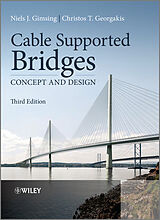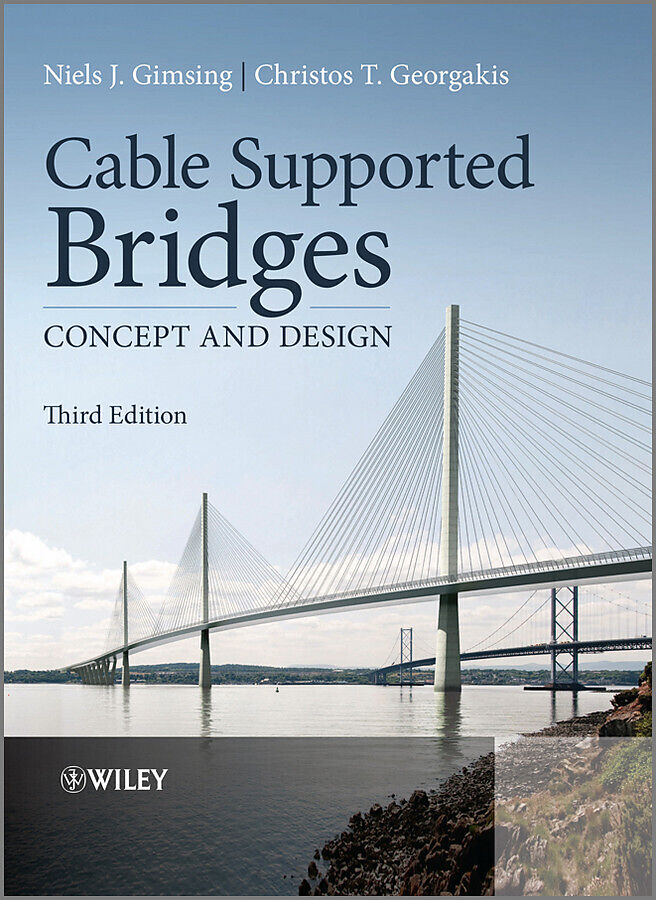Cable Supported Bridges
Format:
E-Book (EPUB)
EAN:
9781119951872
Untertitel:
Concept and Design
Genre:
Bau- und Umwelttechnik
Autor:
Niels J. Gimsing, Christos T. Georgakis
Herausgeber:
Wiley
Auflage:
3. Aufl.
Anzahl Seiten:
512
Erscheinungsdatum:
30.12.2011
ISBN:
978-1-119-95187-2
Fourteen years on from its last edition, Cable Supported
Bridges: Concept and Design, Third Edition, has been
significantly updated with new material and brand new imagery
throughout. Since the appearance of the second edition, the focus
on the dynamic response of cable supported bridges has increased,
and this development is recognised with two new chapters, covering
bridge aerodynamics and other dynamic topics such as
pedestrian-induced vibrations and bridge monitoring.
This book concentrates on the synthesis of cable supported
bridges, suspension as well as cable stayed, covering both design
and construction aspects. The emphasis is on the conceptual design
phase where the main features of the bridge will be determined.
Based on comparative analyses with relatively simple mathematical
expressions, the different structural forms are quantified and
preliminary optimization demonstrated. This provides a first
estimate on dimensions of the main load carrying elements to give
in an initial input for mathematical computer models used in the
detailed design phase.
Key features:
* Describes evolution and trends within the design and
construction of cable supported bridges
* Describes the response of structures to dynamic actions that
have attracted growing attention in recent years
* Highlights features of the different structural components and
their interaction in the entire structural system
* Presents simple mathematical expressions to give a first
estimate on dimensions of the load carrying elements to be used in
an initial computer input
This comprehensive coverage of the design and construction of
cable supported bridges provides an invaluable, tried and tested
resource for academics and engineers.
Autorentext
Niels Jørgen Gimsing & Christos Georgakis, Technical University of Denmark, Lyngby
Professor Gimsing is Professor Emeritus in the Department of Civil Engineering at the Technical University of Denmark and a Consulting Bridge Engineer. He consulted on the design for numerous landmark bridges including the Femern Bridge, third bridge across the Firth of Forth in Scotland, the Messina Strait Bridge and the 47km long motorway bridge across the Gulf of Thailand, and was a Finalist in the Millennium Bridge Competition for a pedestrian bridge across the Thames at St. Paul's Cathedral. He has won numerous design, teaching and research awards for his work within the structural engineering community and is the author of Cable Supported Bridges 2e (Wiley, 1997) and co-author of The Messina Strait Bridge (CRC, 2009). Dr. Christos Georgakis is Associate Professor in Structural Engineering and Prof Gimsing's teaching successor at DTU. He has particular experience in relation to dynamic actions from his work at the Wind Tunnel Laboratory in Copenhagen and is also involved in several research projects dealing with the dynamics of slender bridges such as the Millennium Bridge in London.
Zusammenfassung
Fourteen years on from its last edition, Cable Supported Bridges: Concept and Design, Third Edition, has been significantly updated with new material and brand new imagery throughout. Since the appearance of the second edition, the focus on the dynamic response of cable supported bridges has increased, and this development is recognised with two new chapters, covering bridge aerodynamics and other dynamic topics such as pedestrian-induced vibrations and bridge monitoring. This book concentrates on the synthesis of cable supported bridges, suspension as well as cable stayed, covering both design and construction aspects. The emphasis is on the conceptual design phase where the main features of the bridge will be determined. Based on comparative analyses with relatively simple mathematical expressions, the different structural forms are quantified and preliminary optimization demonstrated. This provides a first estimate on dimensions of the main load carrying elements to give in an initial input for mathematical computer models used in the detailed design phase. Key features: Describes evolution and trends within the design and construction of cable supported bridges Describes the response of structures to dynamic actions that have attracted growing attention in recent years Highlights features of the different structural components and their interaction in the entire structural system Presents simple mathematical expressions to give a first estimate on dimensions of the load carrying elements to be used in an initial computer input This comprehensive coverage of the design and construction of cable supported bridges provides an invaluable, tried and tested resource for academics and engineers.
Inhalt
Preface to the Third Edition ix Introduction 1 1 Evolution of Cable Supported Bridges 7 2 Cables 85 2.1 Basic Types of Cables 85 2.1.1 Helical bridge strands (spiral strands) 85 2.1.2 Locked-coil strands 87 2.1.3 Parallel-wire strands for suspension bridge main cables 88 2.1.4 New PWS stay cables 90 2.1.5 Parallel-strand stay cables 91 2.1.6 Bar stay cables 93 2.1.7 Multi-strand stay cables 94 2.1.8 Parallel-wire suspension bridge main cables 97 2.1.9 Comparison between different cable types 101 2.2 Corrosion Protection 102 2.2.1 Suspension bridge main cables 102 2.2.2 Stay cables 105 2.3 Mechanical Properties 109 2.3.1 Static strength 109 2.3.2 Relaxation 111 2.3.3 Fatigue strength 111 2.3.4 Hysteresis of helical strands 113 2.4 The Single Cable as a Structural Element 115 2.4.1 Transversally loaded cable 115 2.4.2 Axially loaded cable 126 2.5 Static Analysis of Cables 131 2.5.1 Equation of state for a cable subjected to vertical load 132 2.5.2 Stay cable under varying chord force 135 2.5.3 Limit length and efficiency ratio of a stay cable 143 2.6 Bending of Cables 148 2.7 Dynamic Behaviour of the Single Cable 157 3 Cable System 165 3.1 Introduction 165 3.1.1 Pure cable systems 165 3.1.2 Cable steel quantity comparison 170 3.1.3 Stability of the cable system 173 3.2 Suspension System 179 3.2.1 Dead load geometry 179 3.2.2 Preliminary cable dimensions 180 3.2.3 Quantity of cable steel 182 3.2.4 Quantity in the pylon 184 3.2.5 Total cost of cable system and pylon 185 3.2.6 Optimum pylon height 185 3.2.7 Size effect 187 3.2.8 Structural systems 188 3.3 Fan System 202 3.3.1 Anchor cable 202 3.3.2 Preliminary cable dimensions 205 3.3.3 Quantity of cable steel 206 3.3.4 Quantity in the pylon 208 3.3.5 Simplified expressions 208 3.3.6 Total cost of cable systems and pylons 209 3.3.7 Comparison between suspension and fan system 209 3.3.8 Inclined pylons 210 3.3.9 Deformational characteristics 213 3.3.10 Structural systems 217 3.3.11 Reduction of sag variations 221 3.4 Harp System 222 3.4.1 Dead load geometry 225 3.4.2 Intermediate supports 226 3.4.3 Preliminary cable dimensions 227 3.4.4 Quantity of cable steel 229 3.4.5 Quantity of the pylon 229 3.4.6 Simplified expressions 231 3.4.7 Total cost 231 3.4.8 Structural systems 231 3.5 Hybrid Suspension and Cable Stayed System 235 3.6 Multi-Span Cable System 239 3.6.1 True multi-span cable supported bridges 241 3.6.2 Non-traditional multi-span suspension bridges 246 3.6.3 Fixing of column-type pylons to piers 249

Leider konnten wir für diesen Artikel keine Preise ermitteln ...
billigbuch.ch sucht jetzt für Sie die besten Angebote ...
Die aktuellen Verkaufspreise von 3 Onlineshops werden in Realtime abgefragt.
Sie können das gewünschte Produkt anschliessend direkt beim Anbieter Ihrer Wahl bestellen.
Loading...
Die aktuellen Verkaufspreise von 3 Onlineshops werden in Realtime abgefragt.
Sie können das gewünschte Produkt anschliessend direkt beim Anbieter Ihrer Wahl bestellen.
| # | Onlineshop | Preis CHF | Versand CHF | Total CHF | ||
|---|---|---|---|---|---|---|
| 1 | Seller | 0.00 | 0.00 | 0.00 |
